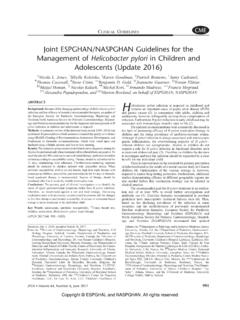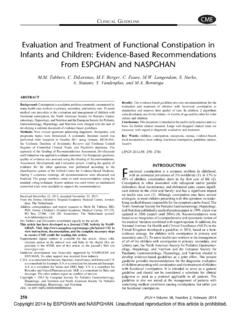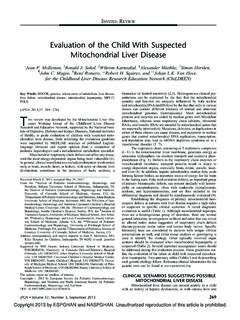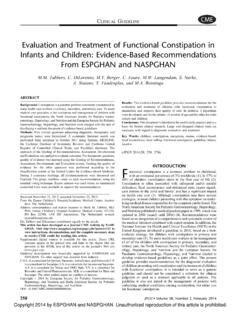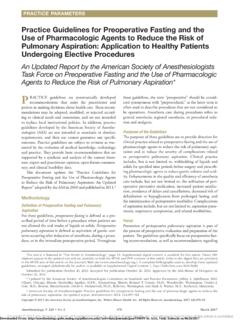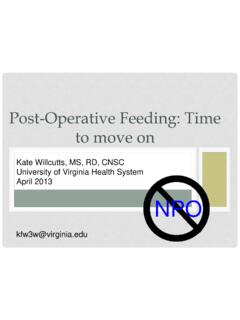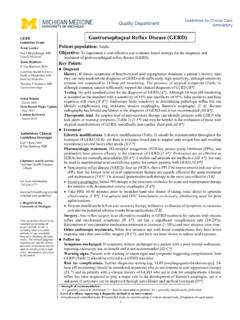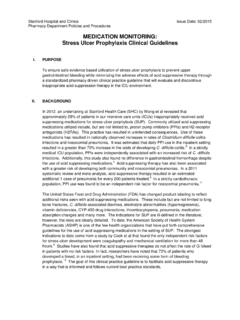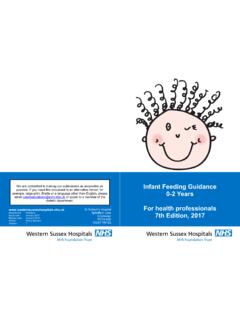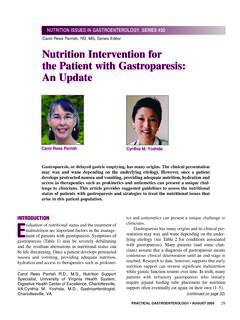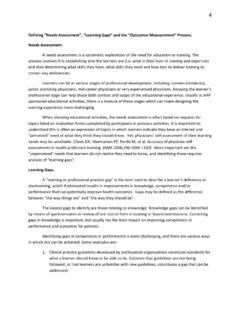Transcription of Pediatric Gastroesophageal Reflux Clinical Practice ...
1 Copyright ESPGHAN and NASPGHAN. All rights Gastroesophageal Reflux Clinical PracticeGuidelines: Joint Recommendations of the NorthAmerican Society for Pediatric Gastroenterology,Hepatology, and Nutrition and the European Societyfor Pediatric Gastroenterology, Hepatology, and Nutrition Rachel Rosen,yYvan Vandenplas,zMaartje Singendonk, Michael Cabana,jjCarlo DiLorenzo, Frederic Gottrand,#Sandeep Gupta, Miranda Langendam,yyAnnamaria Staiano,zzNikhil Thapar, Neelesh Tipnis, andzMerit TabbersABSTRACTThis document serves as an update of the North American Society for PediatricGastroenterology, Hepatology, and Nutrition (NASPGHAN) and the EuropeanSociety for Pediatric Gastroenterology, Hepatology, and Nutrition (ESPGHAN)2009 Clinical guidelines for the diagnosis and management of gastroesophagealrefluxdisease(GERD)ininf antsandchildrenandisintendedtobeappliedi ndaily Practice and as a basis for Clinical trials.
2 Eight Clinical questions addressingdiagnostic, therapeutic and prognostic topics were formulated. A systematicliterature search was performed from October 1, 2008 (if the question wasaddressed by 2009 guidelines ) or from inception to June 1, 2015 using Embase,MEDLINE, the Cochrane Database of Systematic Reviews and the CochraneCentral Register of Controlled Clinical Trials. The approach of the Grading ofRecommendations Assessment, Development and Evaluation (GRADE) wasapplied to define and prioritize outcomes. For therapeutic questions, the quality ofevidence was also assessed using GRADE. Grading the quality of evidence forother questions was performed according to the Quality Assessment of Studies ofDiagnostic Accuracy (QUADAS) and Quality in Prognostic Studies (QUIPS)tools. During a 3-day consensus meeting, all recommendations were discussedand finalized. In cases where no randomizedcontrolled trials (RCT; therapeuticquestions) or diagnostic accuracy studies were available to support the recom-mendations, expert opinion was used.
3 The group members voted on eachrecommendation, using the nominal voting technique. With this approach,recommendations regarding evaluation and management of infants and childrenwith GERD to standardize and improve quality of care were , 2 algorithms were developed, 1 for infants<12 months of ageand the other for older infants and Words:endoscopy, fundoplication, Gastroesophageal Reflux disease,impedance, proton pump inhibitor(JPGN2018;66: 516 554)INTRODUCTIONIn 2009, the joint committee of the North American Society forPediatric Gastroenterology, Hepatology, and Nutrition (NASP-GHAN) and the European Society for Pediatric Gastroenterology,Hepatology, and Nutrition (ESPGHAN) published a medical posi-tion paper on Gastroesophageal Reflux (GER) and GER disease(GERD) in infants and children (search until 2008), using the 2001 NASPGHAN guidelines as an outline (1). Recommendations werebased on an integration of comprehensive and systematic review ofthe medical literature combined with expert 2009, additional publications on the existing benefitsand harms of interventions in the outcomes considered importantand resources available for health care justify the development ofnew a guideline (2).
4 This current guideline aimed to identify studiesthat address the diagnostic and therapeutic approach to infants andchildren with GERD, where GERD is defined as bothersomesymptoms related to GER. This definition is not based on theamount of measured Reflux or on symptoms not clearly attributableto Reflux , and therefore the literature review and discussion isfocused on studies fulfilling this definition. The aim of theseguidelines is to offer guidance to both Pediatric gastroenterologistsand primary care physicians with and without easy access topediatric gastroenterologists. Referral to a Pediatric gastroenterol-ogist for the diagnosis and management of complicated pediatricclinical situations is ideal; however, in situations where a pediatricsubspecialist in not easily available, this guideline considers poten-tial alternative options. The present document provides recommen-dations for the diagnosis and management of GER and GERD ininfants and children.
5 The intent is to serve as a general guideline andReceived February 17, 2017; accepted December 8, the Center for Motility and Functional Gastrointestinal Disorders,Division of Gastroenterology, Children s Hospital Boston, Boston, MA,theyKidZ Health Castle, UZ Brussel, Vrije Universiteit Brussel, Brussels,Belgium, thezEmma Children s Hospital/AMC, Amsterdam, TheNetherlands, the Division of General Pediatrics, University of Califor-nia, San Francisco, CA, thejjDivision of Pediatric Gastroenterology,Nationwide Children s Hospital, The Ohio State University, Columbus,OH, the CHU Lille, Division of Pediatric Gastroenterology, Hepatologyand Nutrition, Lille, France, the#Division of Pediatric Gastroenterology,Hepatology and Nutrition, University of Illinois, Peoria, IL, the Department of Clinical Epidemiology, Biostatistics and Bioinformat-ics, Academic Medical Center/University of Amsterdam, Amsterdam,The Netherlands.
6 TheyyDepartment of Translational Medical Science,Section of Pediatrics, University of Naples Federico II, Naples, Italy,thezzGreat Ormond Street Hospital for Children, London, UK, and the Department of Pediatrics, University of Mississippi Medical Center,Jackson, correspondence and reprint requests to Merit Tabbers, MD, PhD, EmmaChildren s Hospital/Academic Medical Centre, H7-250, PO Box 22700,1100 DD Amsterdam, The Netherlands (e-mail: Rosen, MD, Children s Hospital Boston, Boston, United States(e-mail: digital content is available for this article. Direct URL citationsappear in the printed text, and links to the digital files are provided in theHTML text of this article on the journal s Web site ( ). and shared first Volume 66, Number 3, March 2018 Copyright ESPGHAN and NASPGHAN. All rights not be considered a substitute for Clinical judgment or as aprotocol applicable to all set of guidelines differs from the 2009 guidelines inseveral ways: (1) it focuses on reducing acid suppression wheneverpossible with short empiric trials of 4 to 8 weeks recommended forGERD symptoms; (2) it shifts away from attributing respiratory andlaryngeal symptoms to GER; (3) it adds an algorithm for typicalsymptoms to incorporate Reflux testing to further characterizepatients to differentiate patients with Reflux based diagnoses versusfunctional diagnoses; and (4) it adds a recommendation for changeof formula to a protein hydrolysate or amino acid based formulabefore acid suppression in project started in March 2015 with a literature search forinternational guidelines concerning Pediatric GERD.))
7 This searchidentified 2 guidelines ; that is, the 2009 guidelines of the NASP-GHAN/ESPGHAN and the more recent 2015 National Institute forHealth and Care Excellence (NICE) guideline (1,3). Two reviewers( and ) independently appraised guideline quality usingthe 23-item AGREE-II instrument, which rates reporting of theguidance development across 6 domains: scope and purpose, stake-holder involvement, rigor of development, clarity of presentation,applicability, and editorial independence (available online through: (4). Total scores were calculated as standardized averages bydomain. In conclusion, the NASPGHAN/ESPGHAN 2009 guide-lines were considered of poor overall quality, lacking of appropriateguideline development methodology (ie, due to no clear descriptionof aims and purpose of guideline, target population(s) and outcomemeasures; lack of reproducibility and complexity of data represen-tation). The 2015 NICE guidelines were considered to overall be ofhigh working group agreed that many statements and recom-mendations of the 2009 guidelines are largely still applicable,despite its limitations in methodology.)
8 It was therefore decidedto use relevant and applicable information from the 2009 guidelinesin the development of this present document. The updating processwas then performed by using the approach of the Grading ofRecommendations, Assessment, Development, and Evaluation(GRADE) from October 1, 2008 onward (the end of the 2009guideline s literature search) (5).Using this approach, the project started by formulating 8clinical questions. Questions were chosen first to update the topicsalready addressed by the 2009 ESPGHAN/NASPGHAN GERD guidelines . Second, additional (sub)questions were determined byconsensus agreement on current gaps in knowledge on diagnosisand management of Pediatric GERD. After the questions wereformulated, the guidelines committee was subdivided into groupsthat dealt with each question separately. Questions 1, 2, and 8 wereanswered based on expert opinions and earlier published guidelinesand literature relevant to the research question (1,3).
9 Questions 3, 4,5, 6, and 7 were answered using the results of systematic literaturesearches. Two algorithms, 1 for infants and 1 for children, for thediagnostic and therapeutic work-up for GERD were developed(Algorithm 1 and 2, respectively).Overview of the Clinical Research QuestionsQuestion 1:What is the definition of GER/GERD in infants and children0 18 years?Question 2:What are the red flag findings and diagnostic clues todistinguish infants and children with GERD (or conditionsother than GERD), from GER?Question 3:What diagnostic interventions have additional value tohistory taking and physical examination in infants andchildren with suspected GERD?Question 4:What non-pharmacologic treatment options are effective andsafe for the reduction of signs and symptoms of GERD?Question 5:What are effective and safe pharmacologic treatment optionsfor the reduction of signs and symptoms of GERDQ uestion 6:Which infants and children would benefit from surgicaltreatment such as fundoplication and what are theefficacies of other surgical therapies for GERD?
10 Question 7:What is the prognosis of GERD in infants and children andwhat are prognostic factors?Question 8:What is the appropriate evaluation of infants and children 0 18 years with GERD refractory to non-pharmacologicaland pharmacological treatment?H2 histamine receptor H2; pH-MII pH multichannel intraluminalimpedance; PPI proton pump search:Systematic literature searches were performed by a clinicallibrarian. The Embase, MEDLINE, PubMed and the CochraneDatabase of Systematic Reviews and the Cochrane Central Registerof Controlled Clinical Trials databases were searched from October1, 2008 or from inception for those aspects not addressed in the2009 guideline, to June 1, 2015. Searches were also conducted frominception in case of large inconsistency in findings in comparison tofindings of the 2009 criteria were as follows (all inclusion criteriarelevant to the research question to be met):Guideline development was financially supported by NASPGHAN andESPGHAN.



